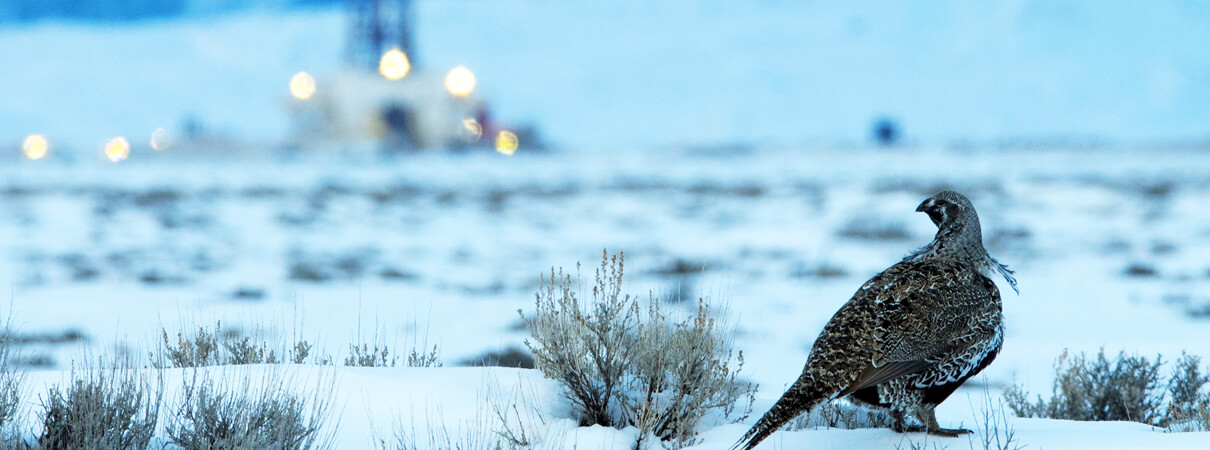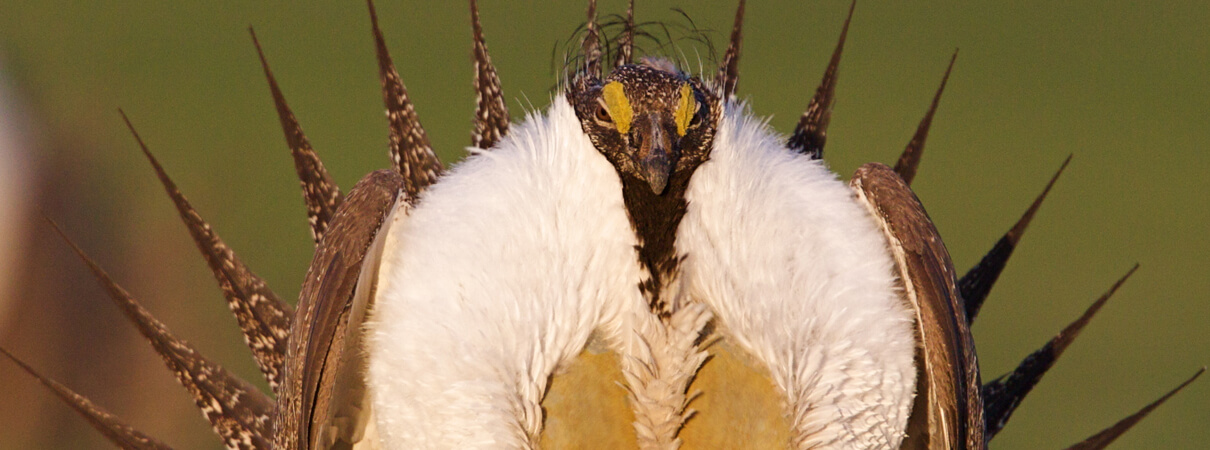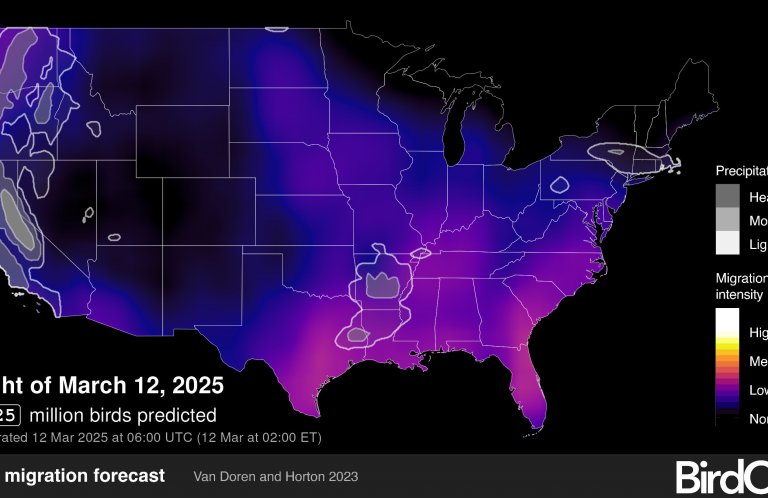With Conservation Plans in Peril, What's Next for Greater Sage-Grouse?
Ty Checketts raises more than 700 Angus cattle on his 50,000-acre ranch in northeast Wyoming. But he also pays close attention to the dozens of Greater Sage-Grouse that live on his land.
Checketts has affixed reflective markers to barbed-wire fences to deter sage-grouse from flying into them. He's preparing to install solar pumps in place of his windmills, which should protect grouse from predatory raptors that use the windmills as perch sites. And he moves his cattle around more, avoiding certain pastures when the birds are present.
“If we have a patch with a lot of sage-grouse on it, I don't put my cows there during lekking time,” Checketts says, referring to the grouse's elaborate mating displays. That's when males form in groups, or leks, and strut for the females, fanning their spiky tails and inflating and deflating their throat sacs to produce a popping sound. Checketts considers himself a conservationist; he loves the grouse and the many species of sagebrush country.
“Our main priority is cattle,” he says. “But by taking care of the cattle and the rangeland, that helps all these species.”

The sagebrush ecosystem the Greater Sage-Grouse depends on is considered one of the most imperiled in the United States. Photo by Noppadol Paothong
The Greater Sage-Grouse is the largest species of grouse in North America. This striking bird, which Lewis and Clark called the Cock of the Plains, relies on vast swaths of sagebrush habitat across the western United States. Without sagebrush, it simply can't survive. Because the birds use such a wide landscape for food and shelter, they're also considered an “umbrella” species: Healthy habitat for sage-grouse means a healthy landscape for mule deer, pronghorn, Sage Thrashers, and more than 350 other species.
But the sage-grouse is in trouble. Populations have plummeted from an estimated 16 million prior to European settlement to fewer than 300,000 today. The sagebrush ecosystem the bird depends on — expansive, treeless landscapes teeming with sagebrush, wildflowers, and native grasses — is considered one of the most imperiled in the U.S., covering only half of its former range.
The bird's range has shrunk, too, from 14 western states to 11, largely due to energy development, crop conversion, habitat fragmentation, invasive species, and wildfires.
For more than a decade, conservationists have been pushing for greater protections for the bird's sagebrush home. Private landowners like Checketts are part of the solution. But their efforts alone won't be enough: Most of the grouse's remaining range is on vast tracts of public lands managed by the federal government and used for a variety of activities, including hiking, fishing, camping, and grazing of livestock.
“For the bird to rebound,” says Steve Holmer, Vice President of Policy at ABC, “it needs healthy, contiguous habitat on these public lands. And that habitat should be enhanced by sustainable management practices — much like the ones that private landowners use on tens of thousands of acres of private lands.”
A Species at Risk
The Greater Sage-Grouse's population hit an all-time low in the 1990s. That's when conservation groups began pushing to have the bird listed under the Endangered Species Act. States began mobilizing, too, to try to conserve the grouse without a listing.
When a species is protected by federal law, a variety of restrictions on land-use practices typically follow, raising fears of hurting local rural economies. A collaboration was born: Over the past several years, federal agencies, conservationists, private landowners, and energy industry representatives rolled up their sleeves to develop conservation plans that would protect the bird and its habitat while still allowing certain land-use practices to continue.
“The plans for federal lands in each state required a lengthy development period and a great deal of compromise. We will need to measure their effectiveness over time and with adequate monitoring,” says Mike Parr, President of ABC. “The plans all have the same core concept, which is avoiding development in areas that are important for grouse.”

Private landowners, conservationists, federal agencies and others rolled up their sleeves in recent years to develop conservation plans for the Greater Sage-Grouse, but under a new administration, those plans are now in jeopardy. Photo by Todd Klassy/Shutterstock
In 2015, the Department of the Interior announced it would not list the Greater Sage-Grouse under the Endangered Species Act. The key to the grouse's future, former Interior Secretary Sally Jewell said, would be the federal conservation plans.
“The epic conservation effort will benefit westerners and hundreds of species that call this iconic landscape home, while giving states, businesses and communities the certainty they need to plan for sustainable economic development,” Jewell said at the time.
The department also promised that future development would be fully mitigated and that the most important grouse habitats would be protected from potential mining. And if grouse populations continued to decline, the plans would be strengthened.
But now, under a new administration, conservationists say those promises have been abandoned, and the future of the federal plans is uncertain. In early October, the new Interior Secretary, Ryan Zinke, announced major changes to sage-grouse management on federal land that would allow for increased energy extraction.
Conservationists fear some of these changes could be devastating for the species. Plans targeting habitat protection for the grouse on public lands were put in place just two years ago, ABC's Holmer says. Weakening the plans puts the grouse at grave risk of further population declines — and threatens the future of an entire region, he says.
“With the future of sage-grouse at risk, we need to make sure the success we've observed on private lands is what we strive for on public lands,” Holmer says.
Sportsmen, business owners, Western elected officials, and conservationists all invested years of work and substantial resources into developing the existing plans, he says. “Now, we're all speaking with a common message: Give the grouse management plans a chance to work.”
Conserving Habitat and Livelihoods
Wyoming is home to more than a third of the entire sage-grouse population. Conservation policies there have tried to focus on managing important areas for sage-grouse to prevent the bird's numbers from dropping further. With energy development, for instance, the state allows an average of only one well pad for every 640 acres in areas that contain large populations of grouse — a limit that's believed to help curb population declines.

The state of Wyoming has placed some limits on energy development in areas that contain large populations of Greater Sage-Grouse in an effort to curb population declines. Photo by Gerrit Vyn
Farther north, particularly in Montana and the Dakotas, sage-grouse are losing habitat to wheat fields. Large belts of land in the region are also used for ranching. Many ranchers have been responsive to calls to help the grouse.
Peter Garrett, whose 80,000-acre ranch near Casper, Wyo., is home to one of the largest populations of grouse in the area, says he used to get nervous when talk of listing the sage-grouse first surfaced 20 years ago. But in the decades since, he has been part of a local working group that identifies and implements sustainable land-use practices. Over the years, Garrett has sprayed invasive cheatgrass, installed fences, and rotates his cattle from pasture to pasture. He now believes the conservation projects have helped his business.
Jewell Reed is another landowner who feels the same way. She raises cattle and sheep on her 20,000-acre ranch in Wyoming, about 80 miles from the South Dakota border.
“It is conserving our livelihood,” she says of the sustainable land-use practices. “If we're on this land and we deplete it and don't put anything back, after a while there's nothing there to feed our livestock, which is our business. After all, that's where our money comes from — eventually it's in the grass. So if we don't take care of the land, it won't take care of us.”
Conservation measures can come at a price, however. Although many ranchers are good stewards of the land, they often can't afford these conservation measures on their own. State and federal agencies have a number of funding opportunities in place for sage-grouse and sagebrush conservation and management. Garrett, for instance, has relied on the Wyoming Game and Fish Department for financial incentives; Checketts partners with the U.S. Department of Agriculture's Natural Resources Conservation Service (NRCS).

"If we don't take care of the land, it won't take care of us," says Wyoming rancher Jewell Reed, who believes sustainable land-use practices that benefit sage-grouse are also good for business. Photo by Tom Reichner/Shutterstock
NRCS' Sage Grouse Initiative (SGI) is the most prominent collaborative effort to protect sage-grouse and manage its habitat. Started in 2010, it involves an array of players, including federal and state agencies, conservation groups, and private landowners. NRCS will spend roughly $760 million on the initiative through 2018. States have contributed as well, spending about $60 million in 2016 on sage-grouse management and conservation.
Since its inception, the SGI has worked with almost 1,500 ranchers across the 11 western states in the grouse's range, says Thad Heater, Coordinator for the Sage Grouse Initiative. “We've put 5.6 million acres of voluntary conservation on the landscape with these ranchers and partners,” he says.
SGI also served as a foundation for another key partnership with landowners, NRCS's Working Lands for Wildlife — a $33 million collaboration among NRCS, the U.S. Fish and Wildlife Service, farmers, ranchers, and forest landowners across the country. This voluntary wildlife conservation initiative, started in 2012, helps landowners implement sustainable agricultural practices that also benefit wildlife.
A Critical Moment
Many of these conservation incentive programs for private landowners are financed through the federal Farm Bill, and should be unaffected by the recent announcements from the Interior Department. But it's unclear what the agency's review will mean for the grouse on public lands. Many are uneasy about what they've learned so far.
“We're concerned about the Secretary's interest and emphasis on sage-grouse numbers as opposed to managing habitat,” says Tom Christiansen, Sage Grouse Program Coordinator with the Wyoming Game and Fish Department. “We're not interested in seeing a wholesale change or starting the process over again.”
It's not just sage-grouse that could potentially suffer as a result of these changes; other birds that rely on a healthy sage habitat would lose out, too. And it's too soon to modify the 2015 plans, says Emily Jo Williams, ABC's Vice President of Migratory Birds and Habitats. “It took many years to work through and get those plans in place and the certainty they provided is now at risk.”

Conservationists say it's too soon to modify the 2015 plans to conserve sage-grouse and its habitat. Photo by Tom Reichner/Shutterstock
For now, it's a waiting game. Federal officials are seeking public comments on changes to the grouse plans; an environmental impact assessment will then follow. It will be years before any changes take root. And conservationists say they anticipate lengthy legal challenges to any rollbacks of the federal plans. ABC's Holmer sees this as a critical moment for the grouse — and the region.
“The Greater Sage-Grouse is an amazing bird, but this is about more than saving a single species,” he says. “It's about maintaining our public lands for future generations and ensuring there will still be wide open spaces. It's about knowing that if we work together to accomplish a shared vision — as hundreds have done to prevent the Greater Sage-Grouse from disappearing — our collective voice will be heard. And it's about trusting that any plan we've developed together is given the chance to prove its worth.”
This article first appeared in the winter 2017-18 issue of Bird Conservation magazine.
 | Divya Abhat is a freelance writer based in the Washington, D.C. area. She has written about wildlife, the environment, and scientific research and discovery for the Atlantic, Smithsonian magazine, and NPR, among other outlets. |


















































